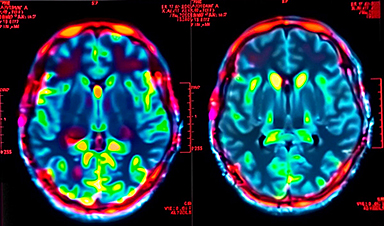Sometimes it is too cold for us and then too warm again – annoying dressing-undressing of sweaters and co. Is therefore required. However, that may change: researchers have developed a sophisticated textile that can independently adapt its thermal properties to how hot, sweaty or cold the wearer is: the innovative fabric warms or cools as needed.
The human organism is like a radiator – we radiate heat. How much infrared radiation we emit into the environment can be regulated by clothing. In this context, material researchers have always developed sophisticated textiles in recent years. However, they can usually only be either or: Some materials insulate extremely well, thereby keeping the body warm. Others, on the other hand, can give off intense heat radiation to cool. A textile that can dynamically move from one function to another has not existed so far, say researchers around Yu Huang Wang of the University of Maryland at College Park. However, this ability should now possess their newly developed material.
Refined fibers with nano-coating
They report that the innovative fabric is made from specially assembled fibers coated with carbon nanotubes. The carrier material is composed of two different polymer materials which react in a contrary manner to moisture and heat with deformation. The dynamic properties of the material are based on this effect, explain the scientists: In moisture or heat, the fibers warp and thus change the structure of the material.
This process opens pores in the fabric that allow heat to escape, the researchers say. But the real highlight is the second effect: The structural change causes an electromagnetic coupling between the carbon nanotubes in the coating. This then leads to increased heat radiation of the material. In sweaty conditions, it thus ensures cooling. On the other hand, if the fabric is cold or dry, the opposite effect occurs: the pores close and the change in the electromagnetic coupling between the carbon nanotubes reduces the heat radiation. This gives the fabric an insulating effect.
“In simple terms, the concept is similar to the effects of radio antennas,” says Wang, “bending two antennas closer together changes their response to electromagnetic waves. The fibers in our material are similar: depending on how close or far they are brought together, their response to infrared radiation changes, “Wang said. At the level of the whole fabric this means that the material can emit more or less heat according to the conditions and thus keep the body warm or cool.
Literally cool clothes in planning
Concretely, the previous test results showed that the infrared-adapive material can change its heat radiation by more than 35 percent. As the researchers report, the fabric also appears to be well suited for use as a textile material with regard to further properties: the basic substances for producing the fibers are readily available and the carbon coating can be applied without problems. In addition, the fabric can be dyed and washed, the developers say.
Nevertheless, the substance has yet to be further optimized and tested until it can be incorporated into products, the scientists emphasize. However, they are confident that some day clothes will be based on their concept: “I find it very exciting to be able to use the material for the development of fabrics that can improve the functionality of garments and other fabrics,” says Co-author Min Ouyang.
Image Credit: Faye Levine, University of Maryland
Thanks to Heinz V. Hoenen. Follow him on twitter: @HeinzVHoenen
News This Week
Does COVID increase the risk of Alzheimer’s disease?
Scientists discover that even mild COVID-19 can alter brain proteins linked to Alzheimer’s disease, potentially increasing dementia risk—raising urgent public health concerns. A recent study published in the journal Nature Medicine investigated whether both mild and [...]
New MRI Study Reveals How Cannabis Alters Brain Activity and Weakens Memory
A massive new study sheds light on how cannabis affects the brain, particularly during cognitive tasks. Researchers analyzed over 1,000 young adults and found that both heavy lifetime use and recent cannabis consumption significantly reduced brain [...]
How to Assess Nanotoxicity: Key Methods and Protocols
With their high surface area and enhanced physicochemical properties, nanomaterials play a critical role in drug delivery, consumer products, and environmental technologies. However, their nanoscale dimensions enable interactions with cellular components in complex and [...]
Nanotech drug delivery shows lasting benefits, reducing need for repeat surgeries
A nanotechnology-based drug delivery system developed at UVA Health to save patients from repeated surgeries has proved to have unexpectedly long-lasting benefits in lab tests – a promising sign for its potential to help human patients. [...]
Scientists Just Found DNA’s Building Blocks in Asteroid Bennu – Could This Explain Life’s Origins?
Japanese scientists detected all five nucleobases — building blocks of DNA and RNA — in samples returned from asteroid Bennu by NASA’s OSIRIS-REx mission. NASA’s OSIRIS-REx mission brought back 121.6 grams of asteroid Bennu, unveiling nitrogen-rich organic matter, including DNA’s essential [...]
AI-Designed Proteins – Unlike Any Found in Nature – Revolutionize Snakebite Treatment
Scientists have pioneered a groundbreaking method to combat snake venom using newly designed proteins, offering hope for more effective, accessible, and affordable antivenom solutions. By utilizing advanced computational techniques and deep learning, this innovative [...]
New nanosystem offers hope for improved diagnosis and treatment of tongue cancer
A pioneering study has unveiled the Au-HN-1 nanosystem, a cutting-edge approach that promises to transform the diagnosis and treatment of tongue squamous cell carcinoma (TSCC). By harnessing gold nanoparticles coupled with the HN-1 peptide, [...]
Global Trust in Science Is Stronger Than Expected – What’s Next?
A landmark global survey conducted across 68 countries has found that public trust in scientists remains robust, with significant support for their active involvement in societal and political matters. The study highlights the public’s [...]
Microplastics in the bloodstream may pose hidden risks to brain health
In a recent study published in the journal Science Advances, researchers investigated the impact of microplastics on blood flow and neurobehavioral functions in mice. Using advanced imaging techniques, they observed that microplastics obstruct cerebral blood [...]
AI Surveillance: New Study Exposes Hidden Risks to Your Privacy
A new mathematical model enhances the evaluation of AI identification risks, offering a scalable solution to balance technological benefits with privacy protection. AI tools are increasingly used to track and monitor people both online [...]
Permafrost Thaw: Unleashing Ancient Pathogens and Greenhouse Gases
Permafrost is a fascinating yet alarming natural phenomenon. It refers to ground that remains frozen for at least two consecutive years. Mostly found in polar regions like Siberia, Alaska, and Canada, permafrost plays a [...]
Frequent social media use tied to higher levels of irritability
A survey led by researchers from the Center for Quantitative Health at Massachusetts General Hospital and Harvard Medical School has analyzed the association between self-reported social media use and irritability among US adults. Frequent [...]
Australian oysters’ blood could hold key to fighting drug-resistant superbugs
Protein found in Sydney rock oysters’ haemolymph can kill bacteria and boost some antibiotics’ effectiveness, scientists discover An antimicrobial protein found in the blood of an Australian oyster could help in the fight against [...]
First U.S. H5N1 Death Sparks Urgency: Scientists Warn Bird Flu Is Mutating Faster Than Expected
A human strain of H5N1 bird flu isolated in Texas shows mutations enabling better replication in human cells and causing more severe disease in mice compared to a bovine strain. While the virus isn’t [...]
AI Breakthrough in Nanotechnology Shatters Limits of Precision
At TU Graz, a pioneering research group is leveraging artificial intelligence to drastically enhance the way nanostructures are constructed. They aim to develop a self-learning AI system that can autonomously position molecules with unprecedented precision, potentially [...]
How Missing Sleep Lets Bad Memories Haunt Your Mind
Research reveals that a lack of sleep can hinder the brain’s ability to suppress unwanted memories and intrusive thoughts, emphasizing the importance of restful sleep for mental health. Sleep deprivation has been found to [...]























Leave A Comment